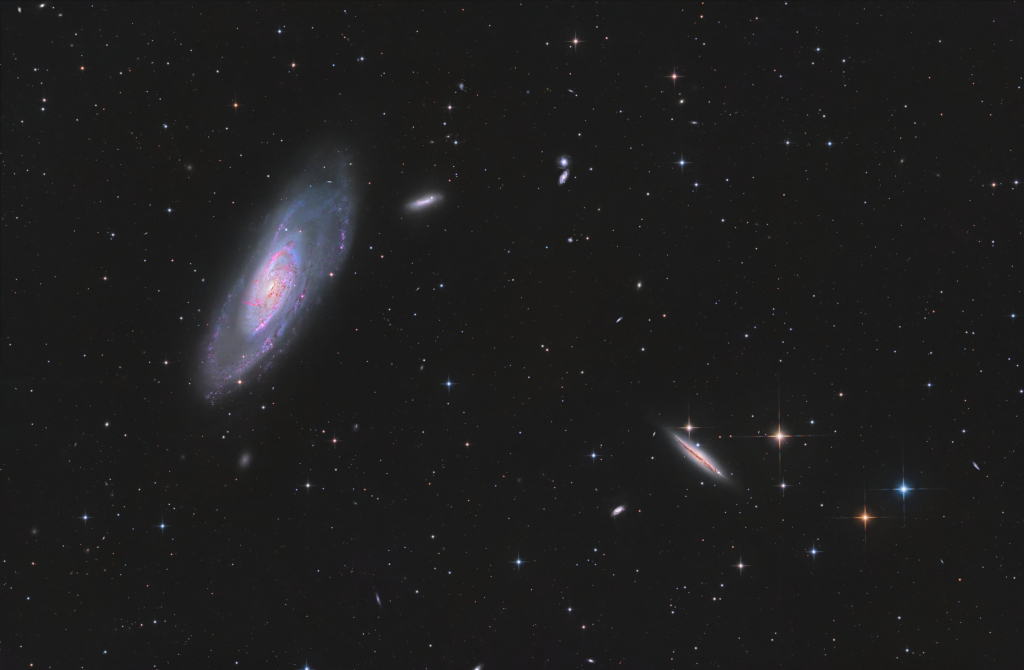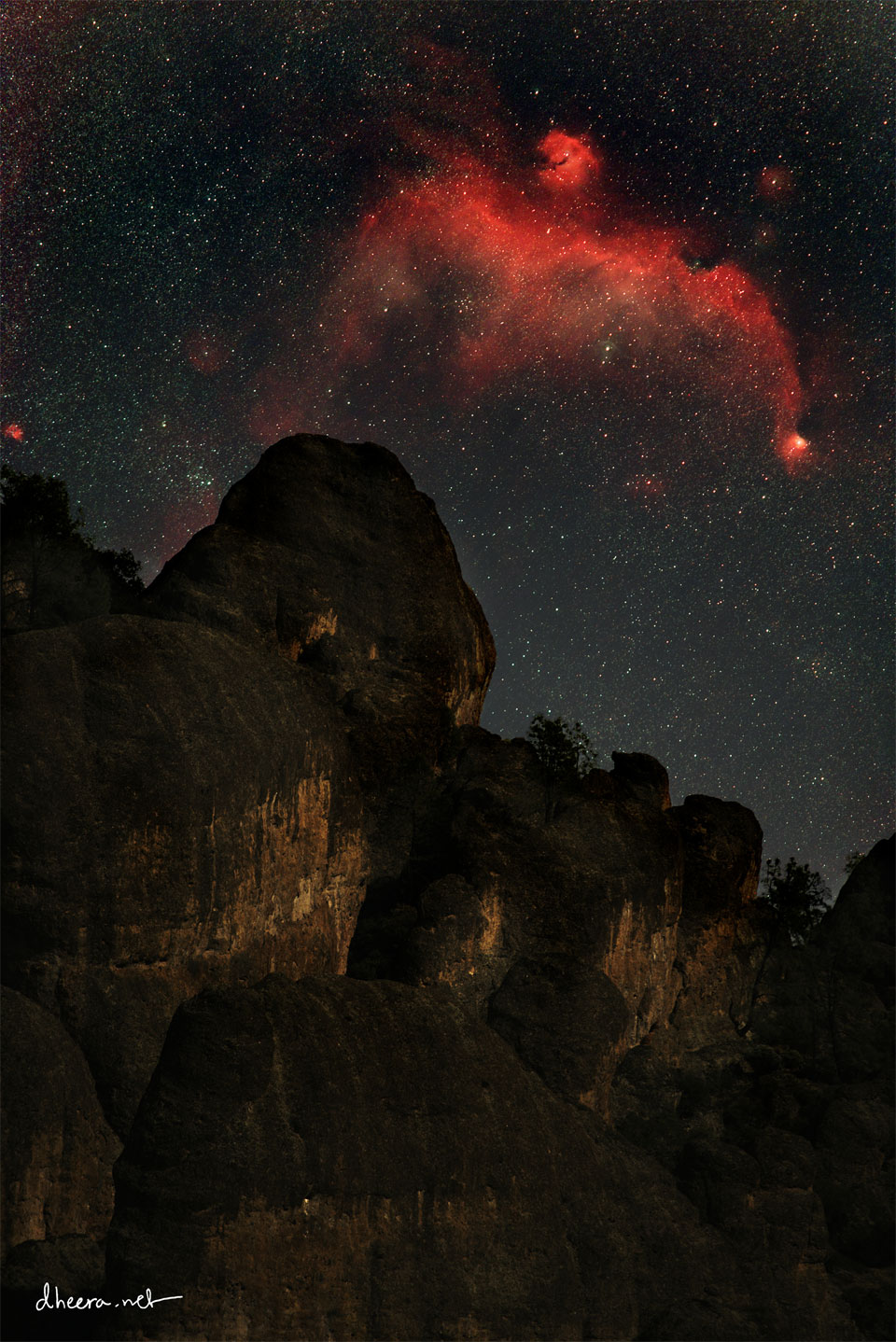
Nombre total de pages vues
22/02/2024
AUTOMOBILE - INVENTIONS QUI N'ONT JAMAIS VU LE JOUR - Pare-brise arrière rabattables

ASTRONOMY - A View Toward M106
2024 February 22
Image Credit & Copyright: Kyunghoon Lim
Explanation: Big, bright, beautiful spiral, Messier 106 dominates this cosmic vista. The nearly two degree wide telescopic field of view looks toward the well-trained constellation Canes Venatici, near the handle of the Big Dipper. Also known as NGC 4258, M106 is about 80,000 light-years across and 23.5 million light-years away, the largest member of the Canes II galaxy group. For a far far away galaxy, the distance to M106 is well-known in part because it can be directly measured by tracking this galaxy's remarkable maser, or microwave laser emission. Very rare but naturally occurring, the maser emission is produced by water molecules in molecular clouds orbiting its active galactic nucleus. Another prominent spiral galaxy on the scene, viewed nearly edge-on, is NGC 4217 below and right of M106. The distance to NGC 4217 is much less well-known, estimated to be about 60 million light-years, but the bright spiky stars are in the foreground, well inside our own Milky Way galaxy.
21/02/2024
SANTé/MEDECINE - Coupe transversale d'une artère humaine obtenue grâce aux ultrasons

MYSTERES SOUS LES LACS - Les yeux de braise d'un couple de crapauds

ASTRONOMY - Seagull Nebula over Pinnacles' Peak
2024 February 21
Image Credit & Copyright: Dheera Venkatraman
Explanation: The bird is bigger than the peak. Nicknamed for its avian shape, the Seagull Nebula is an emission nebula on the night sky that is vast, spanning an angle over five times the diameter of the full moon and over 200 light years. The head of the nebula is catalogued as IC 2177, and the star cluster under its right wing is catalogued as NGC 2343. Consisting of mostly red-glowing hydrogen gas, the Seagull Nebula incorporates some dust lanes and is forming stars. The peak over which this Seagull seems to soar occurs at Pinnacles National Park in California, USA. The featured image is a composite of long exposure images of the background sky and short exposure images of the foreground, all taken consecutively with the same camera and from the same location.
20/02/2024
MYSTERES SOUS L'EAU DES LACS - Quand le brochet est à l'affût

ASTRONOMY - AM1054: Stars Form as Galaxies Collide
2024 February 20
Image Credit: NASA, ESA, STScI; Processing: J. English (U. Manitoba); Science: M. Rodruck (Penn State U. & Randolph-Macon C.) et al.;
Text: Jayanne English (U. Manitoba).
Explanation: When galaxies collide, how many stars are born? For AM1054-325, featured here in a recently released image by the Hubble Space Telescope, the answer is millions. Instead of stars being destroyed as galaxy AM1054-325 and a nearby galaxy circle each other, their gravity and motion has ignited stellar creation. Star formation occurs rapidly in the gaseous debris stretching from AM1054-325’s yellowish body due to the other galaxy’s gravitational pull. Hydrogen gas surrounding newborn stars glows pink. Bright infant stars shine blue and cluster together in compact nurseries of thousands to millions of stars. AM1054-325 possesses over 100 of these intense-blue, dot-like star clusters, some appearing like a string of pearls. Analyzing ultraviolet light helped determine that most of these stars are less than 10 million years old: stellar babies. Many of these nurseries may grow up to be globular star clusters, while the bundle of young stars at the bottom tip may even detach and form a small galaxy.
19/02/2024
MYSTERES SOUS L'EAU DES LACS - Danse avec les nymphéas

ASTRONOMY - Looking Sideways from the Parker Solar Probe
2024 February 19
Video Credit: NASA, JHUAPL, Naval Research Lab, Parker Solar Probe; Processing: Avi Solomon; h/t: Richard Petarius III;
Music: Beethoven's Symphony No. 7, Second Movement; Music Credit: Wikimedia Commons
Explanation: What's happening near the Sun? To help find out, NASA launched the robotic Parker Solar Probe (PSP) to investigate regions closer to the Sun than ever before. The PSP's looping orbit brings it nearer to the Sun each time around -- every few months. The featured time-lapse video shows the view looking sideways from behind PSP's Sun shield during its 16th approach to the Sun last year -- from well within the orbit of Mercury. The PSP's Wide Field Imager for Solar Probe (WISPR) cameras took the images over eleven days, but they are digitally compressed here into about one minute video. The waving of the solar corona is visible, as is a coronal mass ejection, with stars, planets, and even the central band of our Milky Way Galaxy streaming by in the background as the PSP orbits the Sun. PSP has found the solar neighborhood to be surprisingly complex and to include switchbacks -- times when the Sun's magnetic field briefly reverses itself.
18/02/2024
MYSTERE SOUS L'EAU DES LACS - Rassemblement de silures

ASTRONOMY - Apollo 17's Moonship
2025 December 27 Apollo 17's Moonship Image Credit: Apollo 17 , NASA , (Image Reprocessing: Andy Saunders ) Explanation: Awkward an...

-
2022 September 26 All the Water on Planet Earth Illustration Credit: Jack Cook, Adam Nieman, Woods Hole Oceanographic Institution ; Data ...
-
2025 May 11 The Surface of Venus from Venera 14 Image Credit: Soviet Planetary Exploration Program , Venera 14 ; Processing & Copyri...


